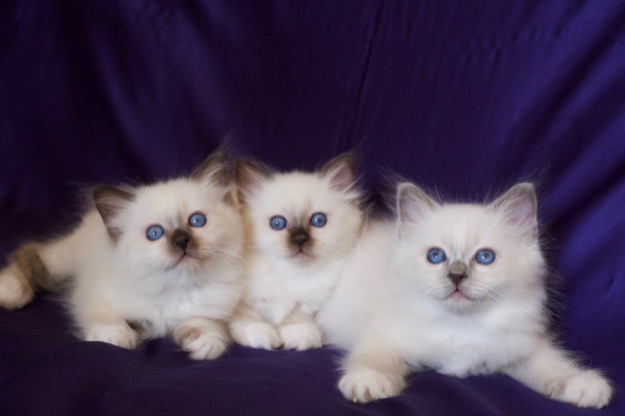We often receive questions about understanding the colors of Birman cats—specifically, how to associate the colors with particular photos. To help with this, I decided to write an article explaining the colors and other related information. All the images used in this article are of our own cats or ones bred by us.
Birman Cats and Their Colors
Similar to Siamese cats, Birmans come in Color Point variations and their subtypes.
What does this mean?
Color Point cats display their color on their face, ears, legs, and tail, while the body remains a lighter shade.
In this image, you can clearly see the contrast between the body color and the color of the face, ears, tail, and legs:
International Champion Hiset Laty Mery, Helena:

All kittens are born white and darken as they age!
The color on their face also evolves, starting from a small chocolate-colored nose and eventually covering their entire face as they grow into adulthood.
For example, no kitten stays like this: Saba Igor:

Instead, they mature into this: International Champion Hiset Laty Mery, Helena:

General Rule:
The older a Color Point cat gets, the darker its coat becomes.
Fun Fact:
A Birman cat’s color can also depend on temperature changes. The colder it gets, the darker the color becomes, including areas on its body. For example, if a Seal Point cat has gum inflammation, the affected area lightens, indicating the location of the issue!
The Main Base Colors
Let’s explore the main base colors, all of which are represented in our kennel either by our own cats or their offspring. 😊
Each color has a specific code, which is standardized worldwide. This is essential information for breeders and cat judges.
- Seal Point (SBI n): This color features very dark, almost black extremities, while the body ranges from platinum to cappuccino tones.
World Champion Moonlight Yenzo, Yoda:

- Chocolate Point (SBI b): Extremities vary from milk chocolate to dark chocolate, while the body has a light, pearly glow, but never white. This color has the strongest contrast between extremities and body color. However, the body also darkens over time, though more slowly than with Seal Points.
International Champion Hiset Laty Mery, Helena:

- Blue Point (SBI a): Extremities are a grayish blue. The body color is darker than Chocolate Points but lighter than Seal Points, with a creamy, gray-brownish tint.
World Champion Azzurro dei Baffi Buffi: - Lilac Point (SBI c): The lightest of all colors. The extremities are lavender, and the body is very pale but not white, with a subtle pearly gray sheen. This color has the least contrast between the extremities and the body.
International Champion Nofretete v Blütengarten Naomi:
These are the primary base colors for Birman cats. However, red and cream colors also exist, and breeders worldwide are working to have new colors recognized by major international cat associations. A rare variation in Birman cats is the tortoiseshell color.
Tabby Variations
I personally prefer only the colors we breed, so I won’t discuss others. However, I do like the tabby variations of the main colors, which are also present in our kennel. With tabby variations, the striping appears only on the extremities, most noticeably on the face. As with the main colors, the color in tabby cats refers to the extremities.
- Seal Tabby (SBI n 21): The tabby variation of Seal Point. The extremities are striped rather than solid. Tabby markings usually make the body color darker than the non-tabby version. You can clearly see the difference between the body colors of Yoda and Dorty.
Blue Sky Doroty:

- Chocolate Tabby (SBI b 21):
Sábacat Julia:

- Blue Tabby (SBI a 21):
Hungarian Champion Sábacat Betti:

- Lilac Tabby (SBI c 21):
International Champion Sábacat Brian (special thanks to the owner for the photo):





